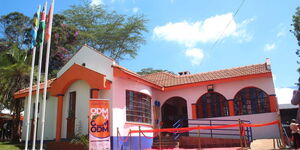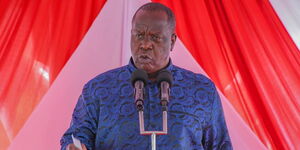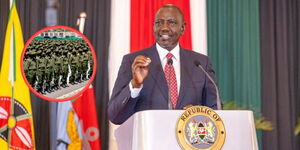The Foreign Affairs Principal Secretary, Korir Sing'oei, is in a race to calm diplomatic waters after President William Ruto's remarks in China stirred an uproar from Uganda and Tanzania.
On Wednesday, April 23, Ruto described two of Kenya's neighbours as Least Developed Countries (LDCs), a statement that did not sit well with most Kenyans and the neighbours alike.
"The difference between us and our neighbours is that Kenya is in the middle-income category. Our neighbours, Tanzania, Uganda and others, are among the least-developed countries or LDCs. We are categorised higher than them, so when they export duty-free, Kenya exports with duty," President Ruto stated.
However, PS Korir has claimed that the viral clip had been taken out of context, and the president was explaining why Kenyan goods have faced more market constraints entering the Chinese markets than in the two countries.
"President Ruto was addressing market access constraints that Kenyan products face in China as a result of Kenya being a non-LDC country. Our neighbours, to the contrary, do not face similar challenges as they are designated as LDCs," part of the statement read.
According to the PS, the United Nations (UN) was responsible for coining the term LDC so that countries that fell under that blanket would be shielded from certain duties and get the support required.
"The LDC category was established by the UN General Assembly in 1971 as an acknowledgement by the international community that special support measures were needed to assist the least developed among the developing countries," the statement stated.
"It is partly the reason Kenya negotiated the EPA with the EU, as LDCs access to the EU market on preferential terms is unavailable to Kenya. A trade agreement with China along these lines will restore our parity of market access."
Ruto's comments came just the same day that a report by the International Monetary Fund (IMF) projected that Kenya's economy would overtake Ethiopia's in 2025 to stand as East Africa's biggest economy.
According to the IMF, Kenya’s Gross Domestic Product (GDP) will be $132 billion (Ksh 17T) in 2025, higher than Ethiopia’s $117 billion, marking a rise from $121 billion (Ksh 15.6T) in the past year, with Ethiopia recording a steep drop from $143 billion.
Ethiopia's drop was attributed to the devaluation of its national currency, the birr, while Kenyan shillings, contrastingly, increased in value.
In July, Ethiopia liberalised its currency after tightly controlling it over the past century, thus leading to its depreciation by more than 55 per cent against the dollar.
The depreciation allowed the East African country to clinch a $3.4 billion loan from the IMF and $16.6 billion from the World Bank and opened the door to talks with creditors on restructuring at least half of its $28.9 billion in external debt.












